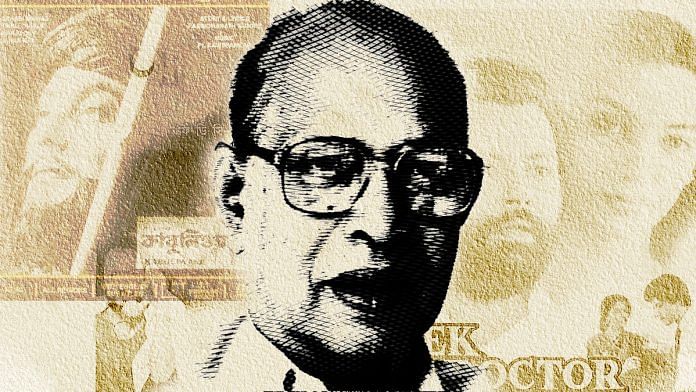New Delhi: Satyajit Ray, Mrinal Sen, Ritwik Ghatak and Tapan Sinha formed a legendary quartet of filmmakers whose body of work became the cornerstone of telling the story of ordinary Indians and their struggles. While Ray’s Pratidwandi (1970) and Shatranj Ke Khilari (1977), and Sen’s Calcutta trilogy are known to be in the hall of fame of political cinema, it was actually Sinha who kickstarted this genre of films with Apanjan (1968).
Sinha has often been described, even by his contemporaries, as one of the finest “middle-of-the-road” filmmakers in the country. Mrinal Sen once said, “We differed in many ways and I did not agree with him all the time, but that does not mean that I do not consider him one of the finest directors in India. I have also never found a human being as good and as powerful as Tapan Sinha.”
His career, which spanned over six decades, began when Sinha was hired as a sound engineer at New Theatres Studios in 1946, after which he joined the Calcutta Movietone Studios — where Mrinal Sen also worked in the sound department. He then went to London in the 1950s to learn film-making. It was upon his return to Kolkata that he finally began his own work.
The kind of films we see today, where the line between parallel and mainstream cinema is blurring, were being made by Sinha long ago. As an artist whose work was ahead of its time as it captured the shortcomings of society — much like the Charles Dickens stories he was inspired by — Sinha earned commercial as well as critical success. But it is widely believed that Sinha is not given due recognition for his work and was often overshadowed by his contemporaries.
In an interview with Silhouette, Abesh Das, author of a book on Sinha, Tapan Sinha — Sarbik Chalachchitra Bikhha, noted, “Not a quarter of discussion had been prevailed upon him comparing the amounts upon Ray, Ghatak or Sen.”
It was only after his death that people in the Bengali film circle, and beyond, began talking about him.
On his 11th death anniversary, ThePrint looks at five films out of his vast filmography that deal with sociopolitical problems.
Also read: Emergency-era censorship affected films so badly that even a spot of blood was cut out
Apanjan (1968)
Set in West Bengal in the 1960s, when the state witnessed a great deal of violence, the film tells the story of an elderly widow (played by Chhaya Devi) who moves to Calcutta where she is scammed by people who claim to be her family. She finds refuge with some young people of the city, who, it turns out, are involved in gang wars spearheaded by political parties. The educated, unemployed youth in Apanjan mirrored society in stark reality, which is why the film resonated so well with the public. It became one of his most well-liked works by the youth. In 1971, it was remade in Hindi by Gulzar, titled Mere Apne and in 1984, in Kannada as Benki Birugali.
Sagina Mahato (1970)
Based on the labour movement of 1942-43, the film tells the story of Sagina Mahato, a tea estate labour leader in Siliguri during the British Raj. Starring Dilip Kumar and Saira Banu, it became an allegory for the Bengal of the 1970s. The story is told using flashbacks and deserves a significant mention in Sinha’s filmography. An entrant in the 7th Moscow International Film Festival, it is based on a story of the same name, written by Bengali journalist and writer Gour Kishore Ghosh as homage to a colleague of his in his political activist past. It was remade in Hindi in 1974 by Sinha himself, with the same cast.
Ekhoni (1971)
Based on Ramapada Chowdhury’s award-winning eponymous novel, Ekhoni addresses the sense of uncertainty the youth felt about their future. Sinha’s choice of Rabindra Sangeet and a stellar starcast of Aparna Sen, Moushumi Chatterjee and Chinmoy Roy earned the film critical and commercial success. The film won a National Award and two BFJA Awards. Scholar Moinak Biswas wrote, “The emergence of a collective protagonist — the unemployed, angry youth, roaming the urban landscape, temporarily displacing and probably permanently changing the nature of the individual male hero and the romantic couple, signaled a major shift in the practice of cinema across the art-popular divide.” He adds, “The character galleries that Sinha creates in Apanjan, and in some ways more poignantly in Ekhoni and Raja, are memorable archives of the times.”
Atanka (1986)
Based on a real-life incident of a teacher — played by the brilliant Soumitra Chattopadhyay — who is witness to a murder planned by his own students, Atanka portrays the tough battle between his conscience and the truth. Abesh Das described his style of film-making as one that is direct in its message, in contrast to Ray’s, who plays with the mind of the viewer. Comparing Sinha and Ray’s style of direction, Das said, “Political castings on the city walls were easily recognizable in Atanka. Insane interference of kakistocratic politics upon youth was much more direct, much more traumatic in Atanka or Apanjan.”
Ek Doctor ki Maut (1991)
In the 1970s, scientist Subhash Mukhopadhyay was ostracised for his research in in-vitro fertilisation and harassed by the government, and eventually committed suicide. The film, inspired by this true story, deals with the complications and “many pitfalls that are created by a lethargic political administration and depicts the lack of infrastructural support to Indian scientists with heartbreaking insight.” Starring Pankaj Kapoor and Shabana Azmi, the film is a classic in its script, acting and, of course, the message it sends.
Also read: Anyone who is not a doctor should watch Pankaj Kapur’s Ek Doctor Ki Maut before blaming them



